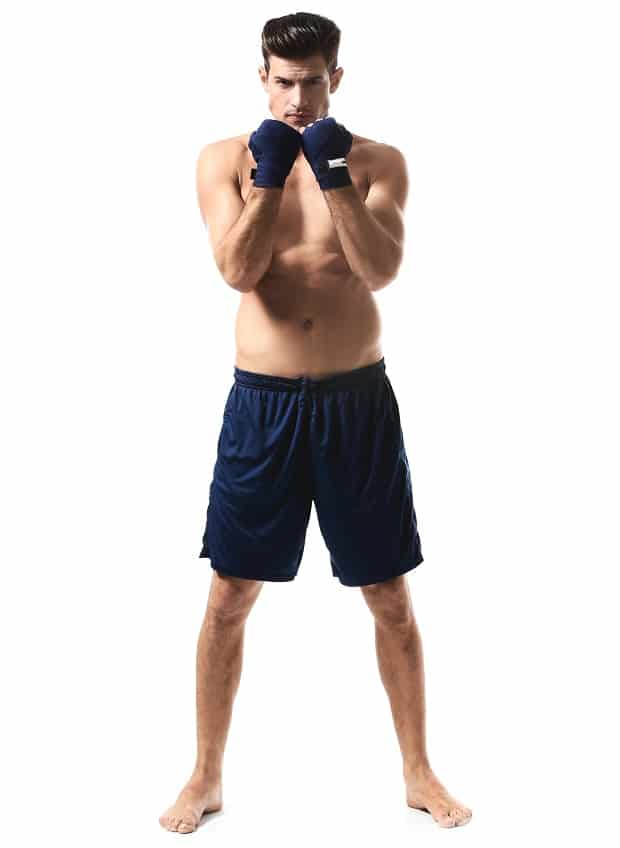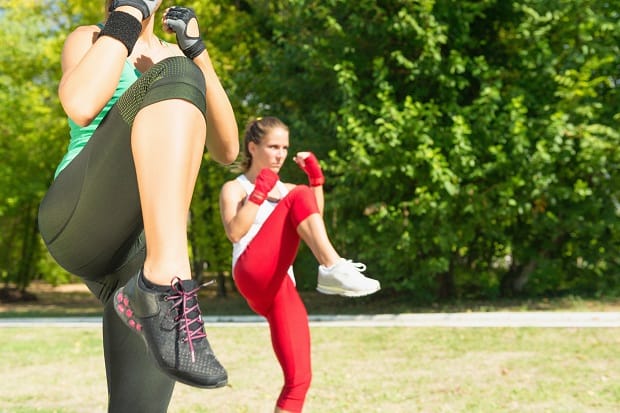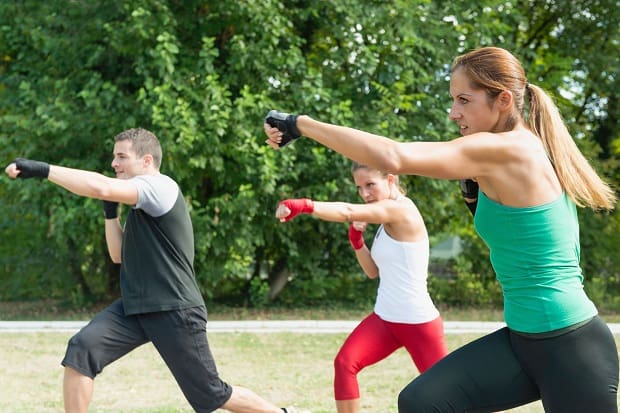The lesson is quite old, the author of the original program is Billy Blanks, who founded the first training center using this method. The birth of this type of fitness is mythologized quite well. There are stories in Runet that Billy starred in films with Bruce Lee. In fact, everything was much more prosaic.
The essence of tai-bo
What is this lesson – tai-bo and what is its peculiarity? The author of the program simply decided to make money on the cult of thinness, which covered America in the 80s. He was at the right time where Pamela Anderson and Paula Abdul were published, and correctly understood the desires of the target audience. The women wanted to finally start eating normally at least sometimes. And regular aerobics from Jane Fonda did not give them such an opportunity. An hour of dancing in swimsuits and leggings and minus a measly 300-400 kcal. Who will be happy with this?
Billy decided to use his experience as a karateka and entertainer mass. Contrary to the tales common in Runet, he did not star with Bruce Lee, but was his fan. Just a guy from a large family who was engaged in karate, then got to Hollywood as a stunt director in films of not the highest order, and then made a fortune on people’s love for food.
Tai-bo in an hour allows you to “remove” up to 800 kcal, because all the strikes are quite intense, and the exits are performed through soft jumps. The bottom line is that for an hour, the practitioner knocks an imaginary opponent in all available ways – with legs, arms, elbows, knees, and so on. It is much more fun and interesting than many other aerobic lessons. Billy quickly became a star.
But he was a much worse businessman than CrossFit’s “dad” Greg Glassman. Billy was able to create a program, release a series of training videos that were quickly leaked publicly, and become a celebrity coach. But he could not sell the franchise. If you go to tai-bo somewhere in central Russia, most likely, the lesson will be invented by a local trainer of group programs and will only be based on popular strikes from martial arts.
Tai-bo training basics for beginners
Tai-bo is considered a suitable lesson for an overweight beginner, but this is not entirely true. People with a BMI over 30, poor posture and weak core muscles should first complete a general physical training course. They should do Pilates and an elliptical trainer 3-4 times a week before starting to intensively “beat the shadow”. This will help protect against the ankle and knee problems that plague beginner aerobics enthusiasts in the heavy weight classes.
Everyone else should understand that:
- You can practice at home under the video, if you have normal body control, when lifting your legs, you are not put on a nearby sofa and you have enough motivation to study on your own.
- It is better to be in a group for those who have problems with self-discipline.
- It is better to train 2-3 times a week if the goal is to burn fat, increase mobility, endurance and improve health.
- As an adjunct to strength and cardio training, you can attend tai-bo once a week.
- It is better to choose a class that will keep up with the time. They are not as different in content as dance or step classes.

Does tai-bo develop stamina?
Tai-bo develops endurance, as it consists of multi-repetitive work of the same type . Punches and kicks are combined into ligaments, the group performs series, rather than single punches. True, such endurance is more useful for “life” and as general physical training before moving on to boxing or martial arts.
Lessons like these do little in terms of strength endurance. So if your goal is to get better at the gym or CrossFit, you need to do them as well.
Positive aspects of tai-bo
The lesson gives a lot of positive, because you will beat your imaginary enemy with a crowd of comrades. Isn’t this what we all dream about, standing in a traffic jam, sitting in a meeting or doing the same type of low-paid job?
But, seriously, this is a good option for “pumping” health:
- relieves stress and emotional tension;
- pumps the heart, and in a fairly high-impact mode;
- improves vascular trophism;
- increases joint mobility and ligament elasticity;
- improves motor skills – stretching and coordination of movements.
Tai-bo can also contain elements for active pumping of the abs or a small series of strength exercises. Billy Blanks’ original videos feature light weight movements like a short body bar. But this lesson cannot be called a power lesson.
Technique for performing individual elements
Technical excellence is not required in tai-bo. You should maintain a neutral back, that is, the shoulder blades tied to the spine, a tucked up abdomen, a slightly tilted pelvis forward and “soft” knees.
Initial stance
The feet are slightly wider than the shoulders, the weight is in the center of the body and is projected in the center of the arch of the foot. Initially, the back is straight, the shoulder blades are pulled to the spine. Before practicing striking techniques, it is worthwhile to slightly round the shoulders forward to ensure the movement of the joints in a safe trajectory.

Straight left and right punch
It is also a jab, performed with a hand that is aligned with the leg facing forward. You need to stand back and forth, bring your right leg forward, bring your hands to your shoulders and perform a short sharp blow with your right hand forward. The legs change with a light jump, the left-side kick is performed in the same way.
Left and right side kick
Side kicks three:
- Uppercut – that is, a blow from the bottom up, to the jaw, is performed from a straight stance along an elliptical trajectory with a turn of the body.
- Cross is a strike from the far arm in a standing position for a direct strike, it is performed with the pivot of the supporting “back” leg and is aimed at the body. The cross should be a strong blow due to the body’s inertia.
- Hook – a side blow to the head with a near hand from shoulder level. In the original lessons, tai-bo is quite rarely used, as Billy does not recommend raising your shoulders high during aerobics.
Leaving (slope) left and right
Grooming is the transfer of weight from one leg to the other with the simultaneous transfer of the body towards the loaded leg. It looks like a “pendulum” with the body from left to right and vice versa. It is learned from the “legs wider than shoulder” stand, first a person learns to perform a tilt along an arcuate trajectory without transferring weight to the leg, then – with a transfer. The second level is going away with a chain of additional steps, then the tilt of the body is repeated several times in the same direction in which the steps are performed.
Kicking
Kicking is used in every workout.
Knee right and left
Knee kicks in tai-bo are closest to how they are beaten in muay thai. The batter transfers the weight of the body to one leg, releases the other, bends it at the knee joint and brings the knee to the shoulder of the same name. In an aerobic lesson, this kick has the format of a “standing abs” exercise.

Back kick
A back kick is performed as a hip extension with additional effort from the knee. It is necessary to transfer the weight of the body to the supporting leg, release the striker and kick back with the heel, sharply unbending the leg at the knee.
Strike Forward
Learning the kick begins with bringing the knee forward, then add knee extension and heel forward kick.
Side strikes
Side kick – after transferring the weight to the supporting leg, a kick is performed from the knee to the side, the heel goes to the side, the body tilts in the opposite direction.
Rond, or roundhouse, is similar to lateral, only the movement of the heel goes “from the inside out”, in an arc. The blow hits the body or head.
Element bindings
For warm-up in tai-bo, a slightly modified aerobic ligament can be used – two side steps to the right and left and swinging arms along the body, plus two side steps to the right and left and synchronized forward strikes.
In tai-bo, the following links are most often used:
- “Jeb, cross, hook, uppercut”, that is, a direct hit, for example, with the right hand, lateral left, lateral “finishing off” with the right and bottom-up with the left.
- Two blows with the left knee, a ligament with the right hands, a jump-off, a repetition from the other leg.
Tempo links will help to increase the intensity:
- 30 seconds of very fast running with high knees, 30 seconds of very fast forward strikes in a stance, the same number of short straight kicks with a change of legs.
- 30 seconds of side kicks, 30 seconds of uppercuts with quick hand changes while standing.
- 30 seconds back kicks with a change, 30 seconds side kicks with a change.
The tempo link is worked at the end of the workout.
Contraindications to exercise
Tai-bo is not a martial art, therefore, no psychological conditions or deviations in this area are a contraindication. If a person has a tendency to aggression, he can do aerobics in order to “throw it off”, of course, if this tendency is not pathological.
Tai-bo is better to postpone:
- Immediately after childbirth. As soon as the doctor permits aerobics and the woman takes 1-2 months of less intense lessons to get back in shape, she can do tai-bo.
- During the period when the ligaments and joints are inflamed, there is soreness in the muscles due to some health abnormalities.
- During acute respiratory viral infections or colds, in case of ailments.
Not recommended:
- with a BMI over 30;
- hypertensive patients;
- for arrhythmias and other heart diseases;
- people with diseases of joints and ligaments.
This workout is not recommended for girls with eating disorders. Such aerobic classes are most often used by bulimics to eliminate the “effects of constipation.” The consequences, of course, cannot be eliminated, but a rash approach to classes, when a girl actively trains for 3-4 hours a day, leads to injuries of the musculoskeletal system, although the lesson itself is devoid of dangerous jumps and other paraphernalia of martial arts.
Also, the lesson is not recommended for persons with mental disorders such as dysmorphia. It seems to them that they always remain fat, even if they have already lost all the excess weight. In the aerobic lessons of the “combat” plan, they look for relief, but it is quite difficult to make it if they mean the relief “on the bone”. Such people are never happy with the result and literally kill themselves with aerobics.

Tai-bo is a great form of aerobics for those looking to lose a few pounds and stay in great shape with a healthy diet. Naturally, for successful weight loss, you need to remember about the daily calorie deficit, which will help you with this lesson, in which you can easily spend about 800 kcal per hour.
